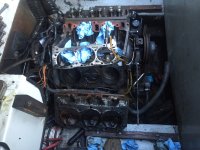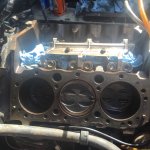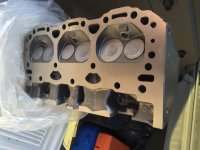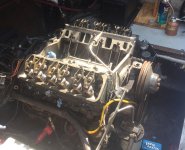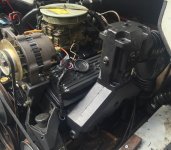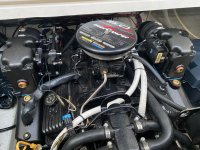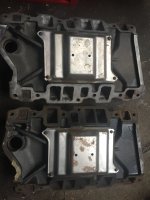Lou C
Supreme Mariner
- Joined
- Nov 10, 2002
- Messages
- 13,706
Well it could have been in the salt but I wouldn’t worry about it too much. I have a lot of experience with salt water use & what I’ve found is that you can get a good 15-20 years of use from the engine before troubles start but the exhaust system needs replacing (at least the elbows) every 5-7 seasons. What eventually happens is that the cooling passages in the cyl heads start to get thin & either don’t seal well against the head gasket or the part of the head behind the valve seats can rust through & hydrolock the engine. I found this out from doing an oil analysis & found sodium in the oil from salt water (2011). A few years later (2013) had an overheat but it ran fine for 2 more seasons & then the head gaskets starting leaking at the end of the third season after the overheat (2016). So I took it apart had the heads checked & the machine shop found that there were cracks in the exhaust valve seat area (overheat) and the cooling passages were getting eroded (salt water use but by then it was in the salt at least16 years). So I installed a set of reman cyl heads with Fel Pro gaskets & ARP head bolts. Also installed new center riser style exhaust. Came out fine still running well 5 years later.
However when I repower this boat FOR SURE the new engine will have a closed cooling system on it! There is no way that'd I'd put a new or reman engine in and leave it raw water cooled here in the Long Island Sound region...many benefits, the only drawback is cost and complexity.
So don’t worry replace the exhaust & go boating! Here's a couple of pix of that job. Not difficult actually just have to keep all the parts organized and CLEAN! I used a thread chaser to clean out the cyl head bolt threads in the block, and new ARP cyl head bolts, the old ones were quite rusty due to the years of raw water cooling. Speaking to a couple of marine mechanics, they said that it is not uncommon for the cyl heads to rust through after that many years of use but the blocks rarely if ever do. So I'll run this one as long as I can but when the time comes I'll repower it. I priced the same boat (Four Winns H1 is the new version, my old one is a F/W H-200) brand new and it's like $67,000. Crazy.
However when I repower this boat FOR SURE the new engine will have a closed cooling system on it! There is no way that'd I'd put a new or reman engine in and leave it raw water cooled here in the Long Island Sound region...many benefits, the only drawback is cost and complexity.
So don’t worry replace the exhaust & go boating! Here's a couple of pix of that job. Not difficult actually just have to keep all the parts organized and CLEAN! I used a thread chaser to clean out the cyl head bolt threads in the block, and new ARP cyl head bolts, the old ones were quite rusty due to the years of raw water cooling. Speaking to a couple of marine mechanics, they said that it is not uncommon for the cyl heads to rust through after that many years of use but the blocks rarely if ever do. So I'll run this one as long as I can but when the time comes I'll repower it. I priced the same boat (Four Winns H1 is the new version, my old one is a F/W H-200) brand new and it's like $67,000. Crazy.
Attachments
Last edited:




















